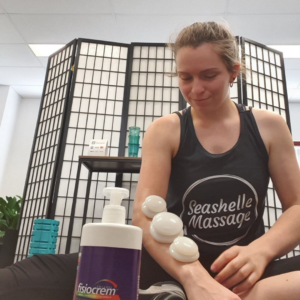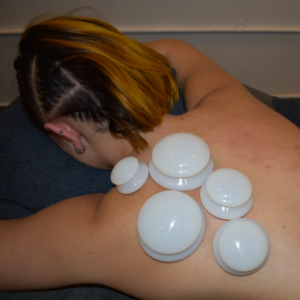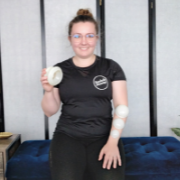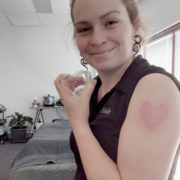You’re mid massage getting a particularly tight spot worked on, and all of a sudden your massage therapist asks if they can do myofascial cupping on you. You’ve seen the octopus looking marks on social media or Olympic athletes but have no idea what it involves or how cupping can help tight muscles… We thought we’d have your back and give you a bit of info!
What is Myofascial Cupping?
Myofascial Cupping (or cupping as it’s better known) is a technique used during massage where ‘Cups’ are placed on the skin with suction used to create a vacuum seal. This seal draws both the skin underneath the cup, as well as the underlying tissues and blood cells upwards.
The cups may be made of glass, plastic or silicone and come in a variety of sizes. Historically the cups are usually round, but we love using our funky heart shaped cups! Once placed on a specific area, the myofascial cups can be held in place or moved around, or sometimes the muscles can be moved under them by doing stretches.
Why does is leave a mark? Is it a bruise?!
Not everyone, but SOME people get circular marks from the cupping, similar to a bruise.
Since the tissue and it’s blood vessels are being brought closer to the surface of the skin through pressure. Interestingly, we’ve found that more inflamed or ‘sore’ areas the worse the mark may be because of the extra blood cells sitting in that area.
In any case, we try not to go as crazy as some of the photos on social media, because we don’t want you to look like you’ve been attacked by an octopus!
So what are the benefits?
Myofascial Release
Cupping breaks up and stretches the connective tissue underneath the skin, helping to increase movement and mobility.
Cups lift and separate soft tissue, to create better fluid movement, stretch fascia and adhesions. This also promotes a deep sensation of relaxation
It Preps The Area To Be Worked On
Therapists can warm up an area to be worked on by temporarily placing a cup on it, while treating another area. This saves time, allowing a client to get the most out of their treatment but also allows the therapist to go in deeper as needed while the area is desensitised.
Increases Blood Flow
The suction of the cups brings the blood to the surface, as well as in and around the muscle to help with the healing process of cell repair, and any muscle tension.
Treats Specific Conditions
Cupping is great at helping to treat specific conditions such as scarring, by breaking up adhesions. It also helps with frozen shoulder, shin splints, carpal tunnel syndrome, sciatica, knee pain, sore backs and other muscle pains.
Decreasing Pain and Discomfort
Many of our clients who get cupping notice a huge decrease in pain afterwards, allowing us to use other remedial massage techniques to further work on the same area without causing discomfort.
Contraindications (when cupping should be avoided)
Cupping should NOT be used on broken/open wound skin or sunburn, as this skin is fairly sensitive and doesn’t need more blood drawn to the area. Myofascial cupping should be avoided for anyone on blood thinners due to easy bruising and causing more harm than good.
As with anything massage related, if you feel uncomfortable with, or don’t like it, you’re always welcome to tell your remedial massage therapist so that they can create the best massage treatment for you specifically.
Keen to try out cupping? Feel free to book in with us below!
Written by:
Charlotte Cound
Remedial Massage Therapist
Shelle Dixon
Remedial Massage Therapist






